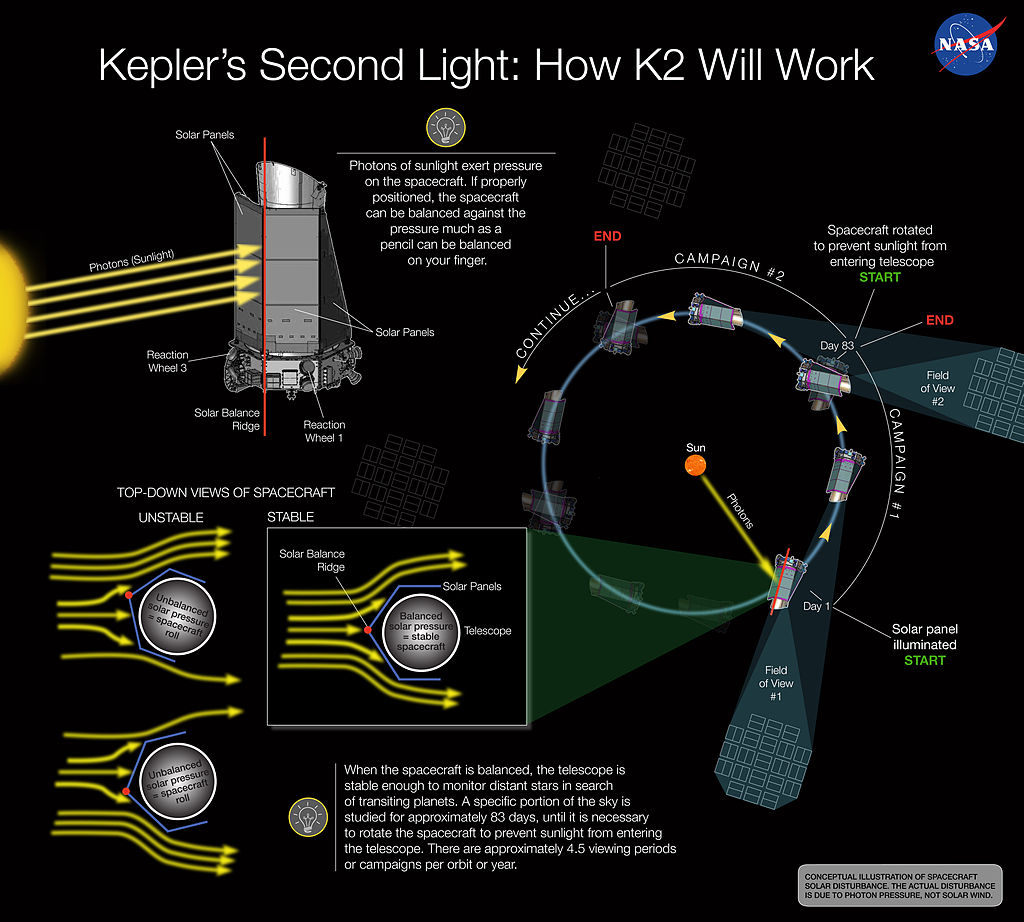Kepler back online
The Kepler spacecraft that was sidelined last year after two of it’s gyroscopes failed has been re-purposed to the K2 mission.
The original mission of Kepler was to continuously observe the same patch of the sky looking for slight dips in the brightness of the star. This indicated that a planet or object transitioned across the star. To determine if there truly was a planet there and it’s orbital period they needed to observe the same dip at least three times. The initial results from Kepler showed planets that were very close to their parent star and yielded a lot of results, as the mission continued they started to see planets that were further out and had much longer orbit periods. Over the four years Kepler was observing they found 962 confirmed exoplanets in more than 76 stellar systems, along with a further 2,903 unconfirmed planet candidates.
 K2 will use approximately 80-day’s of observations per campaign allow it to perform a unique exoplanet survey which fills the gaps in duration and sensitivity of other missions and much better precision than is possible on the ground.
K2 will use approximately 80-day’s of observations per campaign allow it to perform a unique exoplanet survey which fills the gaps in duration and sensitivity of other missions and much better precision than is possible on the ground.
For more information on K2 and how targets will be selected check out the full mission page here.
Orion’s first launch progress
The first test flight of the Orion capsule moved a step closer this week with the attachment of the heat shield. The heat shield which protects the vehicle from the intense heat of re-entry is the largest ever flown.
The test flight which is scheduled for later this year will demonstrate the ability of the vehicle to survive a high speed re-entry similar to those experienced by the Apollo missions that went to the moon.
The mission is tentatively scheduled for December 4th on-board a Delta 4 heavy but that may change depending on progress of the test vehicle.
SpaceX News
This week SpaceX’s COO Gwynne Shotwell gave a talk at the Atlantic Council, during which she gave more details about the success of the company both in there launch successes so far with 9 for 9 in Falcon 9 launches. They currently have 42 missions on the books worth about $4.2 billion, approximately $100 million per mission. She also explained that SpaceX captured 100% of the launch contracts in the Falcon 9 class market during 2011/12.
They are currently producing one Falcon 9 a month and are moving towards increasing this to two. She also talked about the Falcon Heavy test launch and that they are current building the tanks for that flight which is expected early next year.
She also talked more about the up-coming manifest, and addressed the concerns regarding their ability to meet the commitments. She believes that they will prove that they can over the coming months. She then went on to talk about the re-usability of rockets and the change that will bring to the market in the long run.
In other related news Dr. Garrett Reisman of SpaceX indicated that the Dragon V2 vehicle will look to use the 6 hour accelerated approach to the station as the Soyuz does today.
First Laser communications from ISS
This week the Optical Payload for Lasercomm Science (OPALS) experiment on the station this week transmitted it’s first video via Laser. The video can be seen here.
These experiments will eventually lead to higher capacity communications between vehicles in space and the ground. OPALS was delivered to the station on the last SpaceX Dragon mission in the un-pressurized trunk and placed on the outside of the station by the CanadaArm 2.
European Extremely Large Telescope
The European Extremely Large Telescope (E-ELT) will be the largest optical/near-infrared telescope built to far, with a 39 metre main mirror it will gather 15 times more light than any other telescope currently in operation today and will take images that are 15 times sharper than anything Hubble has taken. It will be able to image Earth like planets around other stars and study Jupiter like planets in great detail.
To be built on top of Cerro Armazones in the Atacama Desert of northern Chile the telescope first light is planned for 2022.
See a brochure of the E-ELT here.
ISS HD Earth Viewing Experiment
The HDev experiment is attached to the outside of the International Space Station and provides high definition views of the earth via a UStream channel. Below is a slide show of some of the images from this week.
Leave a Reply